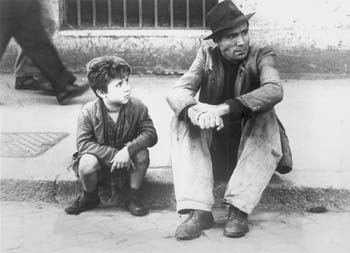![[Metroactive Movies]](http://metroactive.com/movies/gifs/movies468.gif)
[ Movies Index | Metro | Metroactive Central | Archives ]
Return of 'The Thief'
A new print of 'The Bicycle Thief' confirms the film's status as a cinema classic
SOME OF THE FIRST movies ever made were taken completely from life. A century ago, the pioneering moviemakers Louis and Auguste Lumière set up their camera outside a factory's gates in Lyon to film the workers at quitting time. Over the decades, however, cinema developed into an expensive commercial enterprise dependent on artifice and fantasy.
World War II temporarily fractured cinema's thick layers of artifice. The gulf between harsh reality and studio-created fantasy became too much for some artists to ignore. This is how the neorealist movement grew in an Italy starved and shamed after the war. Directors like Roberto Rossellini and Vittorio De Sica brought their cameras out of the studios and into the city streets. Since then, Rossellini's Open City (1946) and De Sica's The Bicycle Thief (1948) have demonstrated how deathless films can be made on practically no budget.
The Bicycle Thief (now being rereleased in a silvery new print) is a regular entry on most critics' lists of the best films ever made. Despite its reputation as a film that revived the use of real life in cinema, The Bicycle Thief has all of the compelling drama of a detective story.
Antonio Ricci (Lamberto Maggiorani) lives with his two children in a Roman slum at the end of World War II. Against much competition, Antonio nets a job hanging advertising posters, work for which a bicycle is required. Unfortunately, his bike is in the pawn shop. With great reluctance, his wife pawns the sheets off of her bed to raise the money to redeem the bike.
De Sica includes a devastating moment, taken right off the streets of postwar Italy: The prized sheets, family heirlooms, are washed and bundled up. After they're pawned, they're taken into the back of the shop, where a little clerk climbs up a three-story-high series of shelves to stash them away alongside the mountain of hundreds of other pawned bedclothes. No lecture on poverty could be quite as much to the point as this image.
During his first day on the job, Antonio's bicycle is stolen by a small gang of thieves. Desperately, Antonio enlists his friends and his son, Bruno, to help track the bicycle down. They search the poor parts of Rome: the flea market, a union rescue mission, the banks of the Tiber and, finally, a brothel where the thief is hiding. Before you quite realize it, De Sica has turned the small tale of one man and his son into a story of thousands upon thousands in the poor and crowded city.
The poor people here are guarded, tense, unsmiling and often mean; they haven't found out that there's supposed to be something spiritual in being broke all the time. Still, the Romans are bustling, always interested in what crosses their paths. Something's always coming up: a quarrel, a conversation, a soccer game or the hue and cry after a thief. These people may be dirt-poor, but they aren't bored--thus, they're not boring.
DIRECTOR De Sica is noted for being one of the first to use actual slum locations and nonprofessional actors. He wanted to remove the gloss from movies and take them out of the context of lovely factory-made objects. "My idea is to deromanticize the cinema," De Sica said. In an obvious bit of irony, Antonio's hard-won job, his first in two years, is a gig putting up movie posters with pictures of Rita Hayworth on them.
If De Sica was looking for casual, unromanticized images, why does a new print of The Bicycle Thief matter? Isn't adequate photography good enough? Maybe, but De Sica, for all his realism, enjoyed artistry. He skillfully set up the action sequences, tracking shots and compositions.
Observe one scene of a sudden rain shower that sends people hurrying in all directions across an intersection. It's a little urban ballet during which a number of extras, all running at cross purposes, somehow don't bump into each other.
The Bicycle Thief also preserves images of a vanished Rome. Now we can see far deeper into the frame to take in the buildings, the bystanders and the everyday litter. The new print will also help viewers study the faces onscreen, especially that of Bruno (Enzo Staiola), a little boy of immense charm--the comic relief and the heart of the film.
What makes The Bicycle Thief among the highest and the best films ever made isn't its apparent lack of scheming but its little bits of unexpected mercy: a man angrily forgiving a theft, a pawnbroker increasing the size of a small loan, Antonio treating his son to a lunch to try to get back into his good graces after having slapped him in anger. In The Bicycle Thief, we see all of those little grudging deeds that keep the world from collapsing under the weight of its own sorrow.
[ San Jose | Metroactive Central | Archives ]
Copyright © Metro Publishing Inc. Maintained by Boulevards New Media.
![]()

Down and Out in Rome: Enzo Staiola (left) and Lamberto Maggiorani try to survive hard times in postwar Italy.
The Bicycle Thief (1948), directed by Vittorio De Sica, written by Luigi Bartolini and Oreste Biancoli, photographed by Carlo Montuori, and starring Lamberto Maggiorani.
From the December 10-16, 1998 issue of Metro.